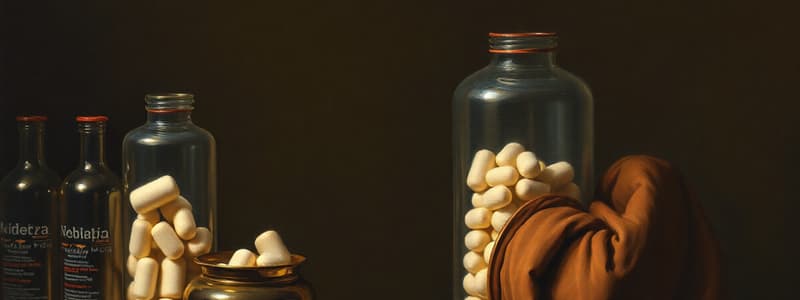Podcast
Questions and Answers
What is a primary disadvantage of the parental route of drug administration?
What is a primary disadvantage of the parental route of drug administration?
- Requires minimal training for administration
- Provides irregular absorption patterns
- Can easily be adjusted if dosing needs change
- Rapid absorption rates can lead to overdose (correct)
Which of the following statements accurately describes modified-release drug products?
Which of the following statements accurately describes modified-release drug products?
- Allow for immediate release of active ingredients
- Are always smaller in size compared to immediate release products
- Can improve patient adherence and therapeutic outcomes (correct)
- Always designed to be taken multiple times a day
Which route of administration typically sacrifices systemic absorption to maintain localized action?
Which route of administration typically sacrifices systemic absorption to maintain localized action?
- Intramuscular injection
- Topical lotions (correct)
- Transdermal patches
- Intravenous injection
What is a characteristic of transdermal patches compared to other dosage forms?
What is a characteristic of transdermal patches compared to other dosage forms?
Which modified-release terminology describes a product that delivers a portion of the drug significantly after the initial dose?
Which modified-release terminology describes a product that delivers a portion of the drug significantly after the initial dose?
What is an essential counseling point for patients using modified-release medications?
What is an essential counseling point for patients using modified-release medications?
Which type of drug delivery is characterized by not requiring regular administration due to its sustained effect?
Which type of drug delivery is characterized by not requiring regular administration due to its sustained effect?
What is one significant risk associated with the use of modified-release drugs?
What is one significant risk associated with the use of modified-release drugs?
Which form of drug administration is administered directly beneath the skin?
Which form of drug administration is administered directly beneath the skin?
What type of dosage form allows for immediate and delayed release of medication within the same product?
What type of dosage form allows for immediate and delayed release of medication within the same product?
What defines the concept of biopharmaceutics?
What defines the concept of biopharmaceutics?
What distinguishes pharmaceutical equivalence from bioequivalence?
What distinguishes pharmaceutical equivalence from bioequivalence?
What is a primary advantage of using drug patches compared to oral medication?
What is a primary advantage of using drug patches compared to oral medication?
Which dosage forms would most likely require caution regarding crushing or cutting?
Which dosage forms would most likely require caution regarding crushing or cutting?
Which section of a drug reference would contain information about ADME characteristics?
Which section of a drug reference would contain information about ADME characteristics?
What is a common disadvantage associated with transdermal drug delivery?
What is a common disadvantage associated with transdermal drug delivery?
What is required for a generic drug to be approved as a Therapeutic Equivalent to the brand drug?
What is required for a generic drug to be approved as a Therapeutic Equivalent to the brand drug?
What key clinical consideration is important for the effective application of drug patches?
What key clinical consideration is important for the effective application of drug patches?
What primarily affects the rate of drug release from a dosage form?
What primarily affects the rate of drug release from a dosage form?
Which characteristic about oral dosage forms is NOT true?
Which characteristic about oral dosage forms is NOT true?
What must a generic drug submit to gain FDA approval?
What must a generic drug submit to gain FDA approval?
Which of the following is NOT a consideration when prescribing outpatient dosage forms?
Which of the following is NOT a consideration when prescribing outpatient dosage forms?
What should be done with an old patch before applying a new one?
What should be done with an old patch before applying a new one?
What is a disadvantage of using oral route for drug administration?
What is a disadvantage of using oral route for drug administration?
Why might there be a delay in drug action after a patch is applied?
Why might there be a delay in drug action after a patch is applied?
The delivery of a drug to the site of action is significantly influenced by which of the following?
The delivery of a drug to the site of action is significantly influenced by which of the following?
What should a healthcare provider primarily assess in relation to generic drugs?
What should a healthcare provider primarily assess in relation to generic drugs?
What safety measure should be followed when discarding used patches?
What safety measure should be followed when discarding used patches?
Bioequivalence of a generic drug means it must reach the site of action at a rate and extent that is:
Bioequivalence of a generic drug means it must reach the site of action at a rate and extent that is:
Why is stability important in the context of biopharmaceutics?
Why is stability important in the context of biopharmaceutics?
What component of a drug product can differ between generic and brand drugs?
What component of a drug product can differ between generic and brand drugs?
What mechanism can lead to increased drug permeation when applying a patch?
What mechanism can lead to increased drug permeation when applying a patch?
Which aspect of a drug’s formulation is likely to affect its absorption rate the most?
Which aspect of a drug’s formulation is likely to affect its absorption rate the most?
What is one of the primary advantages of using the rectal route for drug administration?
What is one of the primary advantages of using the rectal route for drug administration?
What should not be done to patches before application?
What should not be done to patches before application?
Which of the following dosage forms contains a soluble drug in an aqueous vehicle?
Which of the following dosage forms contains a soluble drug in an aqueous vehicle?
How does patch removal affect drug levels in the body?
How does patch removal affect drug levels in the body?
What is the main purpose of a patent granted for a new drug?
What is the main purpose of a patent granted for a new drug?
What effect does an old patch have on the application of a new patch?
What effect does an old patch have on the application of a new patch?
What is the requirement for a generic drug regarding the dosage form compared to its branded counterpart?
What is the requirement for a generic drug regarding the dosage form compared to its branded counterpart?
Flashcards
Generic Drug
Generic Drug
A drug that is chemically the same as a brand-name drug and has the same active ingredient, dosage form, and route of administration.
Therapeutic Equivalent
Therapeutic Equivalent
A drug that has been approved by the FDA to be used for the same purpose as its brand-name counterpart and meets the same standards of safety and efficacy.
Pharmaceutical Equivalent
Pharmaceutical Equivalent
A drug that has the same active ingredient and dosage form as a brand-name drug but may contain different inactive ingredients.
Bioequivalent
Bioequivalent
Signup and view all the flashcards
Abbreviated New Drug Application (ANDA)
Abbreviated New Drug Application (ANDA)
Signup and view all the flashcards
Tablets
Tablets
Signup and view all the flashcards
Capsules
Capsules
Signup and view all the flashcards
Suspension
Suspension
Signup and view all the flashcards
Solution
Solution
Signup and view all the flashcards
Rectal Route
Rectal Route
Signup and view all the flashcards
Biopharmaceutics
Biopharmaceutics
Signup and view all the flashcards
Drug Metabolism
Drug Metabolism
Signup and view all the flashcards
Drug Absorption
Drug Absorption
Signup and view all the flashcards
Drug Elimination
Drug Elimination
Signup and view all the flashcards
Drug Distribution
Drug Distribution
Signup and view all the flashcards
Drug Half-Life
Drug Half-Life
Signup and view all the flashcards
Suppository
Suppository
Signup and view all the flashcards
Parenteral Route
Parenteral Route
Signup and view all the flashcards
Transdermal Patch
Transdermal Patch
Signup and view all the flashcards
Epicutaneous Route
Epicutaneous Route
Signup and view all the flashcards
Immediate-Release (IR) Drug
Immediate-Release (IR) Drug
Signup and view all the flashcards
Modified Release (MR) Drugs
Modified Release (MR) Drugs
Signup and view all the flashcards
Extended-Release (ER) Drug
Extended-Release (ER) Drug
Signup and view all the flashcards
Delayed-Release Drug
Delayed-Release Drug
Signup and view all the flashcards
Repeat Action Drug
Repeat Action Drug
Signup and view all the flashcards
Targeted-Release Drug
Targeted-Release Drug
Signup and view all the flashcards
Transdermal patch advantage: GI drug absorption
Transdermal patch advantage: GI drug absorption
Signup and view all the flashcards
Transdermal patch advantage: First-pass metabolism
Transdermal patch advantage: First-pass metabolism
Signup and view all the flashcards
Transdermal patch advantage: Extended therapy
Transdermal patch advantage: Extended therapy
Signup and view all the flashcards
Transdermal patch advantage: Rapid termination
Transdermal patch advantage: Rapid termination
Signup and view all the flashcards
Transdermal patch disadvantage: Potency limitation
Transdermal patch disadvantage: Potency limitation
Signup and view all the flashcards
Transdermal patch disadvantage: Contact dermatitis
Transdermal patch disadvantage: Contact dermatitis
Signup and view all the flashcards
Transdermal patch disadvantage: Lag time
Transdermal patch disadvantage: Lag time
Signup and view all the flashcards
Transdermal patch disadvantage: Continued diffusion
Transdermal patch disadvantage: Continued diffusion
Signup and view all the flashcards
Transdermal patch clinical consideration: Site of application
Transdermal patch clinical consideration: Site of application
Signup and view all the flashcards
Transdermal patch clinical consideration: Skin condition
Transdermal patch clinical consideration: Skin condition
Signup and view all the flashcards
Study Notes
Introduction to Biopharmaceutics and Drug Dosage Forms/Drug Databases
- Gretchen M. Ray, PharmD, PhC, BCACP, CDCES, Associate Professor, UNM College of Pharmacy, lectured on January 17, 2025.
Objectives
- Define biopharmaceutics.
- Explain the relationship between pharmaceutical equivalence, bioequivalence, and therapeutic equivalence, and how these relate to generic drugs.
- Identify important counseling points and prescribing considerations for various outpatient dosage forms, such as capsules, tablets, oral solutions, suspensions, elixirs, and transdermal preparations.
- Locate information about available dosage forms in a drug reference (such as Lexidrug™).
- Locate sections describing drug administration considerations.
- Locate sections describing ADME characteristics of a drug.
- Determine if it's safe to cut or crush a dosage form.
Supplemental Readings/References
- Shargel L, Yu AC. Applied Biopharmaceutics & Pharmacokinetics. 7th ed., 2016. Accessed: October 24, 2017, at http://accesspharmacy.mhmedical.com/content.aspx?bookid=1592§ionid=100668900.
- Allen LV, Ansel HC. Ansel's Pharmaceutical Dosage Forms and Drug Delivery Systems. 10th ed., 2014.
Biopharmaceutics
-
The relationship between a drug's physical and chemical properties, dosage form, and route of administration affects the rate and extent of drug absorption.
-
Key processes include drug release and dissolution, absorption, distribution, drug distribution in tissues, elimination, excretion, and metabolism.
-
These processes influence the therapeutic or clinical effect.
-
Factors affecting biopharmaceutics include: design of the drug dosage form, stability of the drug, and manufacture of the drug product, release of the drug from the drug product, and rate of dissolution of the drug at the absorption site.
-
Influence therapeutic decisions in prescribing.
Generic Drug Approval
- Generic and brand-name drugs are not identical.
- A new drug application (NDA) approved by the FDA results in a patent.
- Generic companies can market generic versions when the patent expires.
- Generic products must contain the same active pharmaceutical ingredient, be the same dosage form, and use the same route of administration as the brand-name drug.
- ANDA approval requires the generic drug to be a therapeutic equivalent of the brand drug, proven to be safe and effective, and a pharmaceutical equivalent.
- A generic drug must contain similar amounts of chemically active ingredients but may contain different inactive ingredients (excipients).
- The rate and extent of active drug reaching the site of action must be the same as the branded drug (bioequivalence).
Routes of Administration and Associated Drug Dosage Forms
- Oral route (tablets, capsules, suspensions, solutions/elixirs, syrups) is the most frequent administration method, but absorption is slow, variable.
- Rectal route (suppositories) is useful when patients are vomiting or unconscious, approximately 50% bypass the liver, but absorption is irregular.
- Parental route (subcutaneous, intramuscular, intravenous, intradermal) is preferred for drugs destroyed by the GI tract. Absorption is rapid and predictable, but once administered, it is difficult to remove the drug in case of overdose. Sterility requirements and trained personnel needed.
- Epicutaneous route (lotions, creams, ointments, transdermal patches) involves topical application to the skin. Transdermal patches allow sustained systemic drug delivery. Ointments, lotions, and creams are for local action with minimal absorption.
- Ophthalmic, otic, and nasal routes are used for local action. Absorption can be minimal to systemic.
Modified Release Drug Products
- Most oral drugs are considered immediate release (IR).
- Modified release forms alter timing and/or rate of release, improving patient adherence and/or therapeutic effect. Examples include extended-release, delayed-release, enteric-coated tablets, repeat-action, targeted-release, and orally disintegrating tablets (ODTs).
- Modified-release drugs offer sustained therapeutic blood levels, improved patient adherence, improved tolerability, but may suffer from dose-dumping, less flexibility for dose adjustments, and may be more difficult for high doses due to the size of the product.
Clinical Considerations for Oral Modified Release Dosage Forms
- Do not switch back to immediate-release (IR) without considering existing blood concentrations of extended-release (ER) drugs.
- Instruct patients that modified-release tablets and capsules should not be crushed or chewed.
- Some non-erodible matrix shells and osmotic-release tablets may be visible in the stool, and empty shells or ghosts from osmotic tablets should be expected.
- Consult a drug reference if necessary.
Clinical Considerations When Prescribing Drug Patches
- Absorption from transdermal patches varies depending on application site; use package insert instructions.
- Apply patch to clean, dry skin without hair, or consider factors like wet/moist skin, lotion, etc, that may affect drug permeation.
- Do not cut the patch; remove the old patch before applying a new one.
Practice with Drug Database
- Open databases (such as Lexi-Comp) are helpful in checking drug information, searching drugs like amoxicillin (antibiotic), promethazine (anti-emetic), and discussing characteristics (ADME), dosage forms, preparations, administration, pharmacology/pharmacokinetics, pharmacodynamics/kinetics, and indications/contraindications.
- Use the database to determine if it's safe to cut pantoprazole tablets in half.
Studying That Suits You
Use AI to generate personalized quizzes and flashcards to suit your learning preferences.




